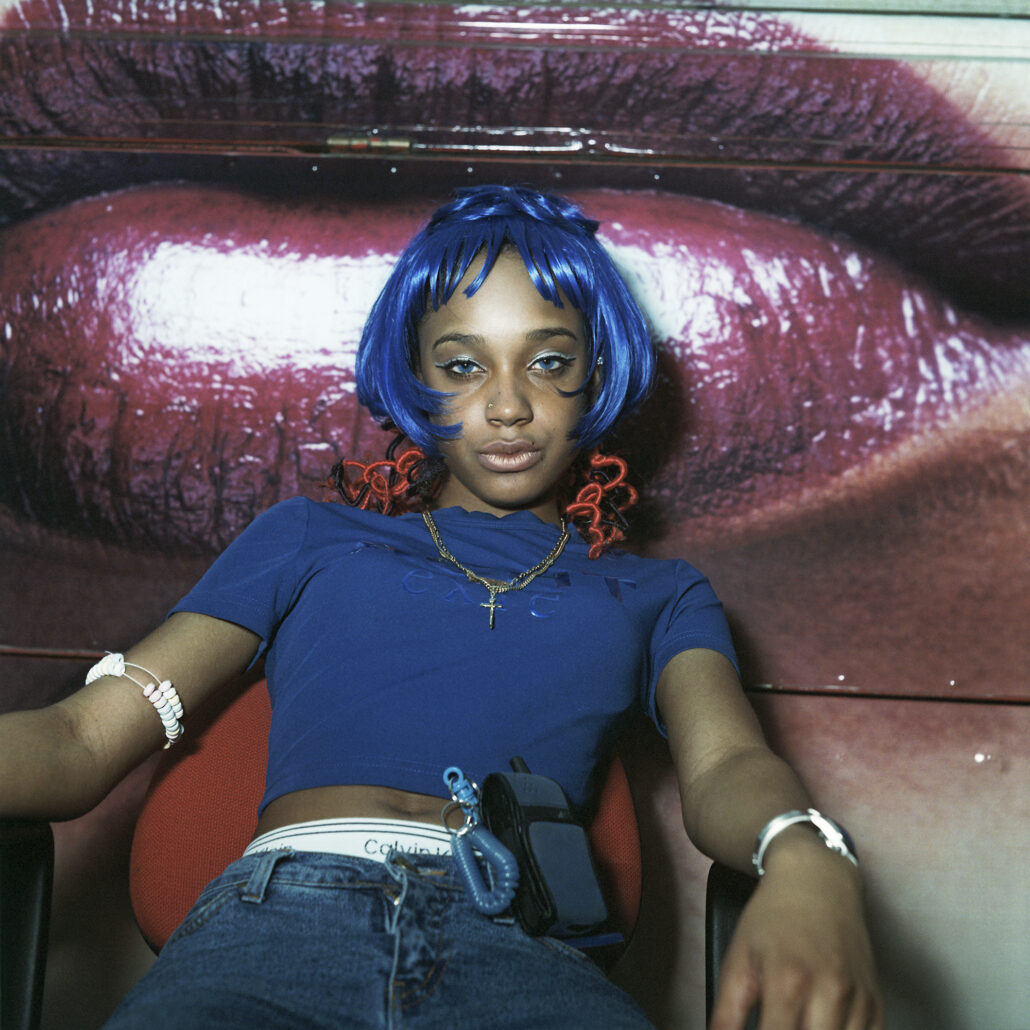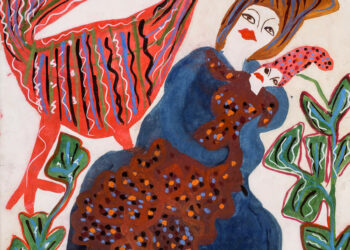This autumn, Somerset House explores the untold stories of Black British fashion in a major new exhibition, ‘The Missing Thread’.

Eileen Perrier, Untitled 1, Afro Hair and Beauty. 1998 © Eileen Perrier
Spanning from the 1970s to the present day, ‘The Missing Thread’, curated by the Black Orientated Legacy Development Agency (BOLD), charts the shifting landscape of Black British culture and the unique contribution it has made to Britain’s rich fashion design history.
Black creativity has had a profound influence on British fashion and continues to be referenced to great effect, often without acknowledgement. The exhibition seeks to redress this, celebrating the unique visions and impact of a generation of trailblazing Black creatives whose contributions have been misrepresented or excluded from the story of British fashion.
Set against a backdrop of politics and culture, the show examines how Black style and creativity has evolved across the decades and in turn influenced the world of fashion through music, photography, art and design.
The exhibition will tell the story of Black creativity through four distinct themes – Home, Tailoring, Performance and Nightlife – each referencing the spaces which inspired and allowed the culture of Black British fashion and design to develop on its own terms. Rather than approaching fashion in isolation, the Black contribution to British fashion culture will be set within the broader socio-political context, placing garments alongside artworks, cultural artefacts, music, memorabilia, videos and installations. ‘The Missing Thread’ concludes by spotlighting the genius of one of Britain’s most influential Black fashion designers, the late Joe Casely-Hayford OBE, presenting the first ever major staging of pieces from the designer’s extensive archive. A series of original commissions by contemporary Black designers will be woven throughout the show, including Nicholas Daley, Bianca Saunders and Saul Nash, celebrating the generational lineage of Black creative excellence in British fashion.
Opening the show, Home explores the intercontinental roots of Black British style and the safety Black Britons found in family, friends and community when faced with the harsh reality of racism in the UK. For many Black creatives, the domestic setting was a place to engage with their international roots, with global ideas about culture and style providing a rich source of inspiration beyond the often-threatening landscape of 20th Century Britain. Visitors enter the space by walking through a brand-new commission by exhibition curator Harris Elliott; ‘Fragile House’, a domicile structure created from steel, adorned with colourful sartorial tape measures reflecting the hope mixed with instability felt by ‘arrivants’ from the Caribbean. Works by artists and designers including Chris Ofili, Maud Sulter, Faisal Abdu’Allah, Christine Checinska, Robi Walters, Zac Ové, Horace Ové and Keith Piper that both celebrate and challenge the central role of the home will feature, drawing on ideas of heritage, memory and identity. In addition, photographer Pogus Caesar’s documentation of the Handsworth Riots in 1985, which were sparked by tension between local Black and Asian communities with the police, sheds light on the precarity of calling Britain home.
The second part of the exhibition explores Tailoring, not just as an expertise and craft, but also as a statement of defiance, aspiration and pride, practiced by Black Britons establishing their own style identity. As well as celebrating the sartorial precision and elegance of tailoring as an artform, the exhibition seeks to unpick how a style of dress, often perceived as the preserve of the elite, has been used as a kind of armour to maintain boundaries and counter racist preconceptions, particularly by Black men. Significant works by both renowned and unsung designers will feature, including a red beaded silk crepe evening dress worn by Princess Diana that was created by couture designer Bruce Oldfield; tailored puffer jacket from acclaimed designer, pattern maker and educator Monisola Omotoso; work from couture designer who trailblazed the use of the leopard print pattern, Ninivah Khomo; a brand-new installation celebrating Ozwald Boateng OBE’s trailblazing work at Givenchy; subversive tailoring exploring subcultures through design by fashion collective Art Comes First; the 2009 England football kit designed by third-generation tailor Charlie Allen and a new commission from designer Wayne Pinnock, whose 1997 Royal College of Art show achieved widespread acclaim. The works will sit alongside photography from Vanley Burke, who captured Black Britons use of tailored style, depicting communities that were and continue to be excluded from national narratives. Meanwhile, stylised portraits of gay Black men in 1980s South London by Rotimi Fani-Kayode provide an alternative vision of Black masculinity that is stripped of sharp suit edges.
Next, the exhibition will delve into Performance, not only spotlighting the achievements of Black performers themselves but breaking down notions of ‘being seen’ and the impact and power of the interpretations that follow suit. Acts of performance from Black cultural figures – whether through dance, fashion, music, film, sporting achievement or beyond – have left a lasting impression on British culture, but the exhibition will go further, exploring how for many Black Britons performance became a part of everyday life, not limited just to those in the public eye. Black people navigating discrimination in Britain were often being observed and monitored; style, hair, attitude, language and movement became a performance rooted in self-preservation, rebellion and resistance. Artefacts including streetstyle garments from Kervin Marc and Walé Adeyemi, iconic 1998 book Sneakers: Size Isn’t Everything by Milk and a vintage Sound System restored by some of London’s finest engineers and selectors, The Mighty Ruler, will feature. Alongside this, the exhibition will feature a breadth of photography including; portraits of Black beauty queens by Raphael Albert; Cynthia Lawrence-John’s documentation of 90s style; 80s street-style photography by Normski, whose work appeared in the likes of The Face and Vogue; Armet Francis, whose fashion shoots in 1970s Brixton have since become iconic and Joy Gregory, whose series of kallitype prints ‘Objects of Beauty’ raise questions about women’s pursuit of changing ideals of beauty. Artist, editor, curator and researcher, Dr Sheyi Bankale, brings sight specific work ‘WYN: Child of God’ to Somerset House. Created from 12-inch vinyl music record boxes, the work features members of the iconic R&B group Destiny’s Child, emblematic of how the interplay between Black culture, music and spiritually is impacted by historical, cultural and social lines. The exhibition will showcase how performance of coolness, confidence and community identity through streetstyle, beauty, sport, sneaker culture or music, was an important source of strength and pride in a hostile society.
Nightlife will celebrate the spaces that provided the freedom and opportunity, beyond the boundaries of mainstream cultural status quo, for Black creatives to meet, network and express individual and collective identity safely. Subcultures at the intersection of fashion and music that grew out of parties and clubs – from rave to hip-hop to reggae to punk – made new ways to engage possible, nurturing the visions of consecutive generations of Black fashion designers. Marc Hare, influential shoe designer known for his work with adidas, Lacoste and eponymous brand Mr Hare, will feature. Visitors are also invited to explore photographs showcasing the central role of subculture and community in finding joy and identity in resistance, featuring the likes of Jennie Baptiste, who photographed the elaborate styles the Dancehall scene; Eileen Perrier, whose portraits recorded the 90s rave-influenced styles of attendees at the Afro Hair and Beauty Show and Ajamu, who depicted Black queer desire. A brand-new short film commission by writer and curator Angela Phillips– who runs the influential archive Instagram account rudeboysandrollups, documenting street style, jungle and garage culture- spotlights dancehall style and the psychedelic tones of the 90s rave scene. The impact of Black music and club culture icons across genres, as the soundtracks of these spaces and scenes, will also be celebrated, including Winn Austin, Sade, Lee “Scratch” Perry and Soul II Soul.
The fifth and final part of the exhibition tells the story of the late Joe Casely-Hayford OBE, who passed away in 2019. The designer, despite being held in quiet esteem within the fashion world, has not been met with the same recognition as his white peers who have become household names. Over a four-decade long career, Casely-Hayford revolutionised menswear, attaining cult status internationally for his subversive Savile Row sensibility and iconic fans including the likes of Lou Reed, The Clash and U2 and shaping the visions of generations of designers who have come since. Working closely with the designer’s family, with exclusive access to the Casely-Hayford archive, the exhibition will close with a substantial showcase of unseen studio material and items from the designers most influential collections. Rare Casely-Hayford items including a T-shirt produced in collaboration with artist Chris Ofili and the outfit worn by Bono in U2’s The Fly music video, will also be on display. In a nod to Casely-Hayford’s alma mater, Central Saint Martins’ fashion students and staff have produced an original piece of textile design out of refabricated tailored shirts, serving as a backdrop to Joe’s most iconic work. In 2009 the designer launched the Casely-Hayford label in partnership with his son Charlie, continuing Joe’s legacy through modern statement tailoring from its iconic Marylebone flagship store.
The exhibition will spotlight the generational lineage of Black creative excellence in British fashion through newly commissioned works from the new wave of contemporary Black British artists and designers who continue to remake the fabric of British fashion today. ‘The Missing Thread’ will feature exclusively crafted works responding to the themes and legacies explored in the show from designers including GQ’s Designer Fashion Fund 2022 recipient, Nicholas Daley; winner of the prestigious grand prize at the 2021 ANDAM Fashion Award, Bianca Saunders and the Somerset House Studios artist who was awarded the 2022 Queen Elizabeth II Award for British Design, Saul Nash.
The curators of the exhibition, The Black Orientated Legacy Development Agency (BOLD) is a creative, design development agency working to forge structural and institutional change across the fashion industry and beyond. The agency is the brainchild of Andrew Ibi, Harris Elliott and Jason Jules. Andrew states, ‘The Missing Thread is a vehicle to examine past, present and future- to contextualise Black fashion culture with authority. Retrospective acknowledgement and recognition of Black cultural contribution is key to this exhibition’.
Global financial services firm Morgan Stanley is headline sponsor of the exhibition. Tosin Akinluyi, Head of EMEA Macro Research for the firm, states, ‘We are proud to support The Missing Thread, which represents an important step on the journey to inclusivity for Black creatives in British culture. In the spirit of allyship we applaud BOLD, Somerset House and all the represented and contributing innovators who are part of the narrative of British identity today, and tomorrow’.
Independent graphic design studio by Carolyne Hill, ChillCreate and multidisciplinary creative studio by Olivier Geraghty, O.G Studios, provide the 2D and 3D design backdrop to the exhibition.
The exhibition will be on view from the 11th of September, 2023, until the 7th of January, 2024. For more information, please visit Somerset House.



